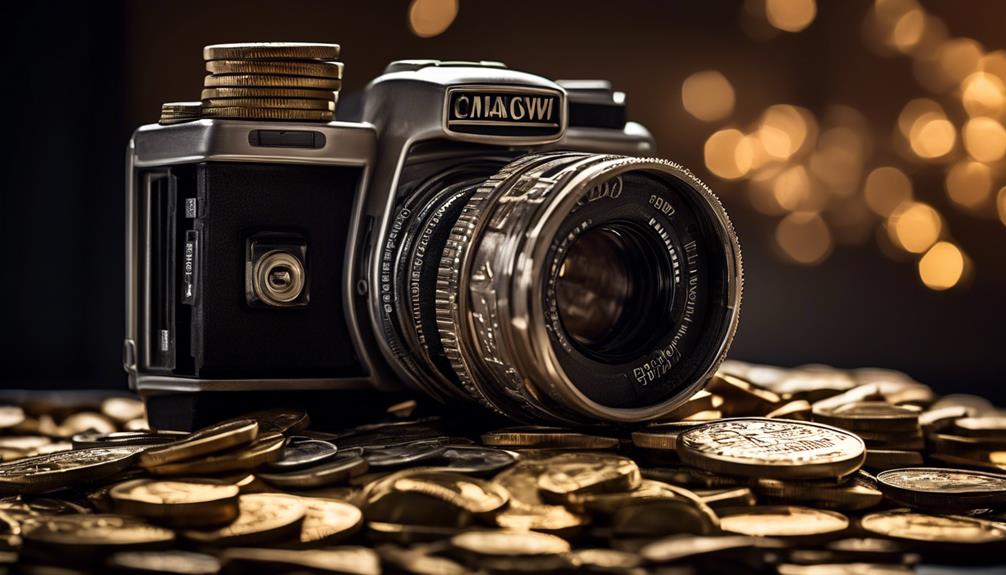Please note this post may contain affiliate links picked by me (Jay) that I have deemed may be of interest or relevant to you the reader of this.
These links do not affect the cost of the thing if you decide to purchase but i may get a little money if you choose to purchase.
For more information on my affiliate link policy click here.
Perfecting pricing presents perhaps the most perplexing puzzle for professional photographers like myself. I’ve spent countless hours honing my craft, capturing moments that speak a thousand words, but when it comes to setting a price tag for my services, the myriad of factors at play can be daunting.
It’s not just about covering costs or matching the market; it’s a delicate dance of valuing your art, understanding your clients’ perceptions, and ensuring your business thrives. I’ve learned that to strike the right balance, one must consider the intricate interplay of skill, experience, and the unique value proposition we bring to the table.
Yet, even with a well-thought-out pricing strategy, the question lingers: how does one adapt to the ever-changing landscape of client expectations and industry standards without compromising their worth?
Join me as I explore the subtle art of crafting a pricing model that reflects the true value of our vision and dedication.
Assess Your Cost Structure

Before setting your prices, it’s crucial to dive deep into the nitty-gritty of your cost structure to ensure your photography business isn’t just surviving, but thriving. I’ve learned, sometimes the hard way, that meticulous expense tracking isn’t just about keeping the lights on; it’s about illuminating the path to financial growth and sustainability in this dynamic field.
Every lens I purchase, every mile I travel, every minute of post-production — it all adds up, and it’s all vital to understanding where my money’s going. But it’s not just about tallying costs; it’s about leveraging those numbers to set profit margins that reflect the value I bring to each click of the shutter.
As I navigate the ever-evolving photography market, I’ve found that a keen grasp on my expenses isn’t merely administrative — it’s a strategic tool. It empowers me to price my services not just competitively, but with a vision that aligns with the innovative desires of my clients.
In a world where creativity meets commerce, a well-assessed cost structure is the foundation upon which I build my pricing strategies — ensuring that my passion for photography is also a testament to financial acumen.
Analyze Market Rates
Having grounded my pricing in a thorough understanding of costs, I now turn my lens to scrutinizing market rates, ensuring my fees not only cover expenses but also resonate with the current photography landscape. It’s about striking that delicate balance—being fair to myself and appealing to clients.
Here’s how I delve into the market dynamics:
- Conduct a competitor analysis: I examine the offerings and price points of peers in my niche, identifying the value propositions that make their services stand out.
- Survey potential clients: I actively seek feedback to understand what clients value and what they’re willing to pay for exceptional photography.
- Monitor industry trends: I stay abreast of technological advancements and emerging styles to ensure my pricing reflects the cutting-edge nature of my work.
- Apply pricing psychology: I fine-tune my rates by considering the psychological impact of numbers, creating packages that seem more attractive and provide perceived value.
This approach isn’t just about numbers; it’s a blend of art and science. I’m passionate about my craft and confident in the worth I bring to each click. Pricing isn’t just about survival—it’s a statement of my brand’s value and innovation in a vibrant market.
Define Your Brand Value

What sets my photography apart in a sea of shutter clicks isn’t just the quality of the images, but the unique narrative each frame conveys, embodying my brand’s distinct value. Brand differentiation lies at the heart of my approach; it’s the cornerstone that ensures clients understand the unparalleled experience they’ll receive. I’m not merely taking pictures; I’m crafting stories, encapsulating emotions, and preserving moments with a perspective that’s unmistakably mine.
To me, value perception is everything. It’s about showing potential clients that what I offer extends far beyond a commodity; it’s an intimate artistic collaboration. The value I provide is intricately tied to the authenticity and consistency of my work, and that’s what commands my pricing strategy. My images don’t just capture; they speak, they resonate, they linger in the memory.
I’ve honed my craft with the understanding that innovation isn’t just about the latest gear or trendy techniques; it’s about how I see the world through my lens and share that vision with others. My brand’s value isn’t a static concept—it’s a living, evolving promise of quality, creativity, and engagement that sets the foundation for how I price my services.
Structure Packages Strategically
Recognizing the unique value my photography brand offers, I now craft service packages that reflect and cater to the diverse needs of my clientele with the same precision and care that defines my artistry. I’ve found that strategic structuring isn’t just a selling point, but a pivotal aspect of my business’s success. Here’s how I do it:
- Competitive Bundling: Offer packages that combine services and products in ways that competitors don’t, adding unique value that clients can’t resist.
- Tiered Options: Create levels of service that allow clients to choose based on their budget and needs, ensuring accessibility while maintaining premium offerings.
- Customization: Allow room for add-ons or alterations, which demonstrate my flexibility and client-centered approach.
- Clear Outcomes: Each package clearly outlines what the client receives, so there are no surprises—only delight in the value provided.
Adjust Based on Feedback

Listening to client feedback has become the cornerstone of refining my photography packages, ensuring they remain both relevant and resonant with my audience’s evolving preferences. I’ve learned that the emotional impact of my work is as vital as its aesthetic quality. That’s why I constantly seek out what my clients think, feel, and desire through client surveys and informal conversations.
This invaluable feedback becomes the catalyst for innovation within my service offerings. I’m not afraid to pivot, embracing pricing flexibility to adapt to the nuanced needs of my market. It’s a dynamic dance between my creative vision and the ever-shifting landscape of consumer demand.
When a pattern in feedback emerges, suggesting a particular package is either overpriced or undervalued, I don’t hesitate to recalibrate my pricing structure.
Frequently Asked Questions
How Do I Handle Clients Who Ask for Discounts or Try to Negotiate Prices Down?
When I’m faced with clients pushing for discounts or lower prices, I stand firm on my value. I’ve honed my negotiation tactics to be clear yet flexible within reason.
My discount policies are transparent, ensuring clients know exactly what to expect. I’m passionate about my craft and confident in the quality I deliver, which justifies my pricing.
Innovating in my approach keeps me ahead, even in these conversations.
What Should I Do if a Competitor Undercuts My Prices Significantly?
When I face significant price undercutting by a competitor, I don’t panic. Instead, I focus on reinforcing my market positioning and value proposition.
I’m confident in the unique services I offer and the quality I deliver. It’s not just about being cheaper; it’s about providing an innovative experience that justifies my prices.
I’ll also analyze my business model to ensure I remain competitive while staying true to my brand’s worth.
How Do I Respond to Clients Who Don’t Understand the Value of My Work or Why Photography Costs What It Does?
Oh, I just adore it when clients act like my camera operates on magic, not skill.
Here’s the deal: I dive deep into value education. I patiently explain the craft, the gear, and the time that goes into every shot.
It’s all about client communication—painting the picture of my passion and experience. That way, they grasp not just the price, but the innovation and dedication behind every pixel.
Should I Ever Work for Free or in Exchange for Exposure, and if So, Under What Circumstances?
I’ll consider pro bono projects if they offer significant exposure or unique portfolio-building opportunities.
However, I’m selective, ensuring these collaborations align with my vision and brand.
It’s not just about free work; it’s a strategic choice to enhance my creativity and reach.
I weigh each offer carefully, because while exposure doesn’t pay bills, the right project can open doors to innovative paths and future paid engagements.
It’s about smart investment in my craft.
How Do I Increase My Prices Without Losing Existing Clients?
I’m boosting my rates, focusing keenly on pricing transparency and clear value communication. To keep my clients on board, I’m passionately conveying the enhancements in my skill set and the superior quality they’ll receive.
It’s about articulating the worth and innovation behind each photo. I’m experienced enough to know this approach maintains trust and justifies the new pricing, ensuring my clients understand they’re investing in top-notch, ever-evolving artistry.
Conclusion
Navigating the art of pricing is like capturing the golden hour; it’s all about finding that perfect balance. I’ve learned to marry the nuts and bolts of my expenses with the market’s heartbeat, and to infuse the unique essence of my brand into every package.
Listening to the whispers of client feedback, I adjust my lens, ensuring every quote reflects the true value of the moments I freeze in time. Remember, in this gallery of business, your price tag is your signature.


